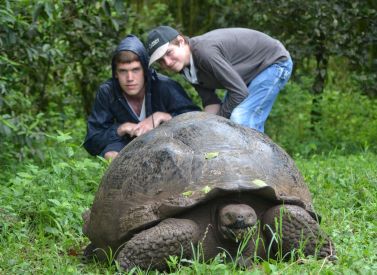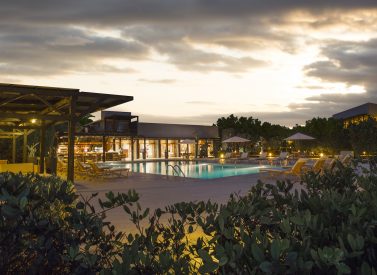
Galapagos Legend, Boutique Cruise Ship
A classic of the Galapagos, the Legend surpasses expectations
The Legend houses up to 100 guests with a wide variety of cabins to suit every traveller’s needs.
Stable in the water, the Legend is also the fastest passenger vessel in Galapagos and as a result, can offer incredibly varied itineraries.
Although a larger yacht, it is beautifully appointed and retains a cosy, homely and intimate atmosphere.
The classic, yet contemporary interiors perfectly balance the huge open deck space, so whatever your mood, there is a little book to reflect your feeling.
More about The Legend
The boat underwent a refit in 2017. This meant the addition of:
- 18 luxurious balcony suites;
- The new Charles Darwin Panorama Lounge with huge floor to ceiling windows; and
- A spectacular al fresco BBQ featuring a unique lifeboat dining experience.
The Legend is also equipped with a glass bottom boat, transparent kayaks, a kid’s corner, a naturalist centre, boutique, snorkeling equipment room and a full auditorium facility.
And don’t forget – the boat also offers a pool, perfect for relaxing in the evening.
Choose from 4-days to 2-weeks aboard this classic Galapagos cruise.
Trip Highlights
Print Share Download as PDF-
Variety of cabins, some with private balconies, to suit every traveller's needs
-
Fastest boat in Galapagos, to whisk you from highlight to highlight
-
Swimming pool aboard boat that was refitted in 2017
-
Glass-bottomed boat, transparent kayaks and snorkelling equipment to maximise your enjoyment
-
Charles Darwin Panorama Lounge with huge floor to ceiling windows
-
Kid’s corner, a naturalist centre and onboard boutique
Tom always got back to us really quickly, answered our questions clearly and gave us lost of really useful information and details. We were very impressed.
It gave us so much confidence in Andean Trails, unlike other replies we got from other agents, which were also much slower.
We decided to travel with you because of Tom’s efficiency and friendliness.
J Fairweather, UK, Legend, 2018
Full Itinerary
Itinerary A: North and Central
Itinerary A (4 days) Mon-Thu
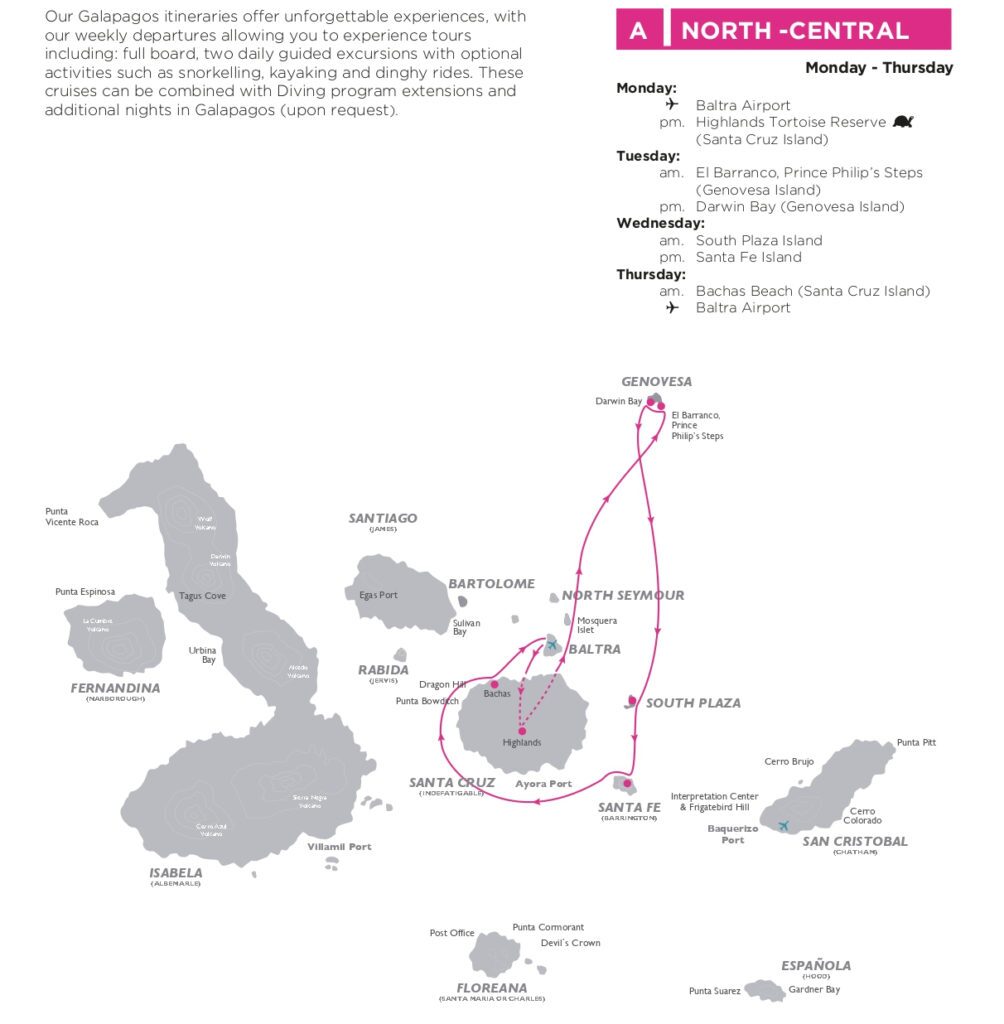
Day 1: Arrive Baltra, transfer via Highlands Tortoise Reserve to yacht (L,D)
Departure from Quito or Guayaquil to Baltra Island (2.5-hour flight approx.).
Arriving in the Galapagos, you are picked up at the airport by your guides and taken to a ten-minute bus drive to the pier to board the Legend.
Our first trip is the Highlands Tortoise Reserve on Santa Cruz Island. In the highlands of Galapagos it is possible to admire different kinds of birds, such as tree and ground finches, vermillion flycatchers, paint-billed crakes, yellow warblers, and cattle egrets (usually standing on the tortoises’ shell).
Our road journey goes from the coast through the agricultural zone and straight up to the dense humid forests. Often, Galapagos Giant Tortoises are also seen on the way, wandering through pastures in the paddocks. This spot is a bird watchers’ haven since almost every land bird present on the island lives or migrates here.
Difficulty level: easy
Type of terrain: flat & muddy sometimes (seasonal conditions)
Duration: 45-minute drive / 1 ½-hour walk
Extended Cruises only
People on longer cruises than the 4-day cruise will take a different route today. Don’t worry – you’ll vist the Highlands later on in your itinerary.
Your alternative today is Black Turtle Cove.
This cover is on the north shore of Santa Cruz Island, accessible only by sea. Here, four species of mangrove crowd and form an internal lagoon; turtles visit the calm waters, peaking their heads above the surface while fish, rays circle below. White-tipped reef sharks can be seen beneath the boat, plus sea birds, including pelicans, herons and egrets. This cove has been declared as a turtle sanctuary.
Difficulty level: easy
Type of terrain: water
Duration: 1-hour dinghy ride
Day 2: Genovesa: AM – Prince Philip’s Steps. PM – Darwin Bay (B,L,D)
Located far to the north of the archipelago, Genovesa is a highlight of any visit to the Galapagos.
Marvel at the variety of sea life that uses the crevices of the lava cliffs for shelter. Red-billed Tropicbirds fly overhead, switching between their nests and the bay, and a small colony of fur seals may be found near the landing site.
You will be dropped off at a steep stairway that begins on rocks at the foot of a path that leads through a seabird colony full of Nazca and Red-footed Boobies. At the plateau, the trail continues inland allowing you to see more nesting booby colonies in the thin Palo Santo forest.
Near the end of the trail, over a rocky lava plain, Wedge-rumped Storm-Petrels can be observed flying in all directions. If you are lucky, you may catch a glimpse of a Short-eared Owl.
Difficulty level: Moderate
Type of terrain: rocky – lava
Duration: 45-minute walk
PM – Darwin Bay (Genovesa Island)
Disembark onto a small sand and coral beach. A short trail heads west along a tidal lagoon and then up a rocky hill that leads to a point overlooking the cliffs and Darwin Bay. Along the trail near the tidal lagoon, you may see pairs of Swallow-tailed Gulls, Lava Gulls, Yellow-crowned and Lava Herons.
The trail continues through Palo Santo trees, Opuntia cacti, and Saltbushes inhabited by Great Frigate birds and Red-footed Boobies. This is one of the few places in the islands where visitors are guaranteed to see Red-footed Boobies.
It is estimated that more than 200,000 Red-footed Boobies live in the trees and bushes of Genovesa.
Difficulty level: Moderate
Type of terrain: Sand & Lava
Duration: 2 ½-hour walk approx.
Day 3: AM – South Plaza. PM – Santa Fe (B,L,D)
South Plazas is located to the east of Santa Cruz, and despite its small size, some of the most interesting and outstanding species of the Galapagos are found here.
Throughout the island we find several hybrid iguanas, a result of crossing a male marine iguana and a female land iguana. These unique animals, recognisable at first glance by their black/grey colour, have the face and tail of the marine iguana.
We also find Swallow-tailed Gulls nesting in the rugged cliffs along with other sea birds such as Frigate Birds and Brown Pelicans.
Difficulty level: intermediate
Type of terrain: rocky
Duration: 2-hour walk
PM – Santa Fe Island
Wet landing. Santa Fe has white sand beaches surrounded by sea lion colonies. Once onto the sandy shore, we follow the island path, passing an endemic cactus forest which is home to the Santa Fe land iguanas (the largest in the islands).
This island is also the habitat for a number of species, including the Galapagos hawk, Galapagos snakes, rice rats (one of the few endemic Galapagos rodents), a variety of finches and one of the four mockingbird species of the archipelago.
Difficulty level: intermediate
Type of terrain: rocky
Duration: 1 ½-hour walk / 1-hour deep-water snorkeling
Day 4: Bachas Beach, transfer to airport OR continue to itinerary B (B)
Wet landing. On the north side of Santa Cruz; behind the beach lies two small flamingo ponds where iguanas sunbathe.
Here, you can also see coastal birds, Darwin finches, mockingbirds, and gulls, as well as native vegetation like red and black mangroves and salt bushes.
Bachas Beach is one of the main sea turtles nesting sites in the Galapagos. A turtle can lay eggs 3 or 4 times per season with an average of 70 eggs each time.
We will also find the remains of barges that sank here a long time ago, when the United States Navy operated a base during World War II on Baltra Island. Local people modified the word barges to “Bachas”, giving the site its current name.
Difficulty level: easy
Type of terrain: sandy
Duration: 1-hour walk / beach time
Baltra Airport
After the visit, you are transferred to the airport for your return flight to Guayaquil or Quito OR keep on cruising aboard the Legend (see itinerary B).
Itinerary B: West
Itinerary B (5 days) Thu-Mon
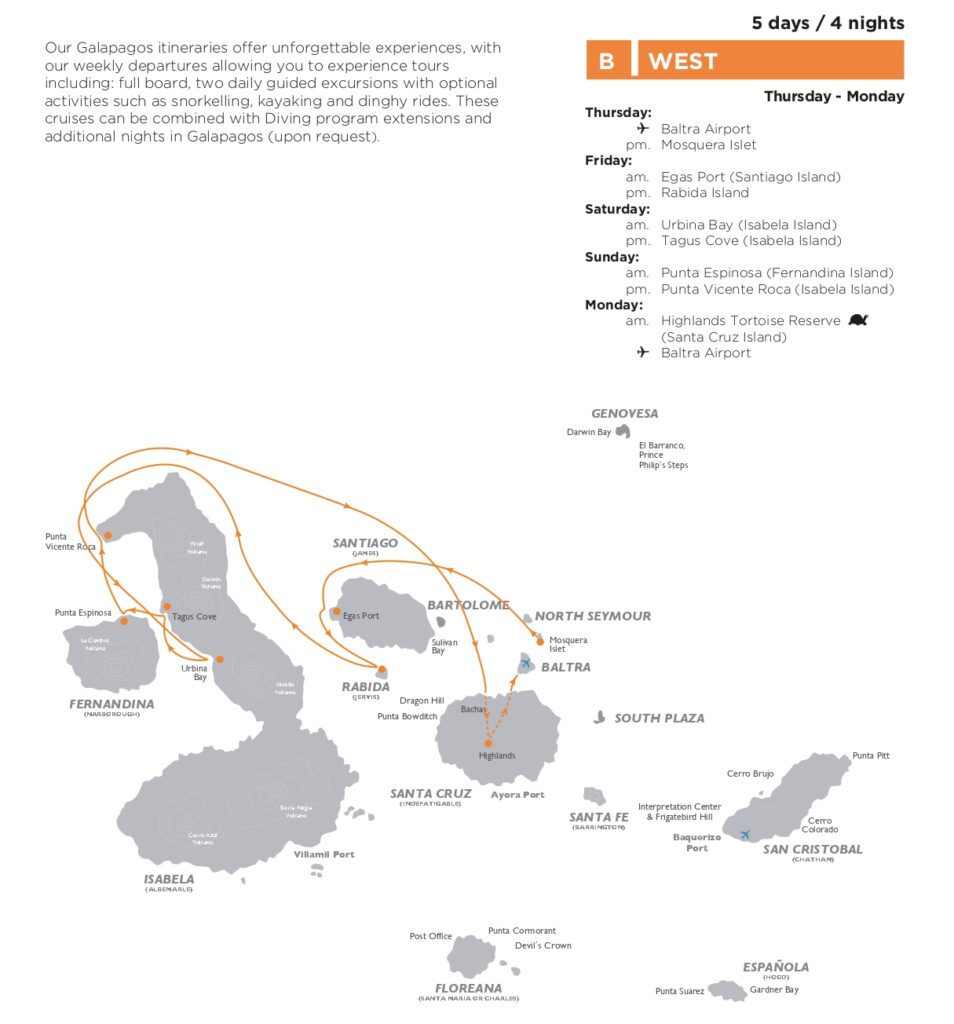
Day 1: Fly to Baltra, transfer to yacht. PM – Mosquera Islet (L,D)
Departure from Quito or Guayaquil to Baltra Island (2 ½-hour flight approx.).
Arriving in the Galapagos, youare picked up at the airport by the boat’s guides and taken, via a ten-minute bus drive, to the pier to board the Legend.
PM – Mosquera Islet
It’s a wet landing to get us started in Galapagos.
Mosquera Islet is located between North Seymour and Baltra Island. This flat, sandy island has a large colony of sea lions. It is also an excellent site to observe shorebirds such as herons and lava gulls.
There is no trail on the islet so you can enjoy the open area and explore. Most of the islet is covered with sand and barren lava rock. Tiny sesuvium portulacastrum plants grow on the sand.
Difficulty level: easy
Type of terrain: sandy
Duration: 1 ½-hour walk & snorkelling
Day 2: AM – Egas Port (Santiago). PM – Rabida Island (B,L,D)
Egas Port is a black volcanic sand beach, visited by Darwin in 1835.
We start again with a wet landing, then a walk. The first section of the trail is formed of volcanic ash (eroded tuff) and the other half is an uneven terrain of volcanic basaltic rock.
The unique, truly striking layered terrain of Santiago shore is home to a variety of animals including the bizarre yellow-crowned night heron and marine wildlife including lobster, starfish and marine iguanas grazing on algae beds alongside Sally light-foot crabs.
It is easy to see colonies of endemic fur seals swimming in cool water volcanic rock pools.
Difficulty level: intermediate
Type of terrain: flat & semi-rocky
Duration: 1 ½-hour walk/ 1-hour snorkelling
PM – Rabida Island
Wet landing again – but you will be used to them by now.
Dark-red sand covers the unique beaches of this island, home to sea lions’ colonies; Rabida is considered the epicenter of the Galapagos Islands due to the diversity of its volcanic geology.
Nesting brown pelicans are found from July through September plus nine species of the famous Darwin’s finches. Here a dinghy ride along marine cliffs is done, to observe nesting seabirds. S
We snorkel off the coast, where marine life is particularly active.
Difficulty level: easy
Type of terrain: sandy
Duration: 1 ½-hour walk / 1-hour snorkelling / 1-hour dinghy ride
Day 3: Isabela: AM – Urbina Bay. PM – Tagus Cove (B,L,D)
Wet landing (might be difficult due to the tide) – so put all that practice into good use here.
This volcanic black beach, depending on the season, gives us the possiblity to find giant tortoises, land iguanas, and the flightless cormorant.
After a short walk inland it’s snorkeling time, a chance to swim with sea turtles, sea lions, and countless tropical fish.
Urbina Bay also features a wide variety of plants with the different range of colours in flowers, attracting different insects, birds, and reptiles. One of the highlights of the island is the uplifted coral reef that resulted from the 1954 seismic activity; from here the views of Alcedo Volcano are remarkable.
While navigating from Urbina to Tagus Cove whale watching is usual in May – December.
Difficulty level: intermediate
Type of terrain: flat & rocky
Duration: 1 ½-hour walk / 1-hour snorkelling
PM – Tagus Cove (Isabela Island)
Dry landing on Galapagos’ largest island where we will learn about the eruption of the five volcanoes that form it. The trail leads to Darwin’s salt-water crater lake and excellent views of lava fields and volcanic formations.
We return by the same path for a dinghy ride along a shoreline full of marine wildlife, where we canadmire a variety of seabirds, such as Blue-footed Booby, Brown Noddy, terns, Flightless Cormorant and depending on the season, a large number of Galapagos Penguins which are only 35 cm tall; the only penguin species in the world to live in the tropics.
The population of penguins on the islands number about 2,000 individuals, most of which live on this western portion of Isabela; others are scattered further south. Graffiti believed to have been left by 19th-century pirates is a curious reminder of an intriguing past.
We also snorkel here – which can be an excellent change to swim with penguins, cormorants and much more.
Difficulty level: intermediate/difficult
Type of terrain: steep/steep
Duration: 2-hour walk / 40-minute dinghy ride / 1-hour deep water snorkelling
Day 4: AM – Espinosa Point (Fernandina). PM – Punta Vicente Roca (Isabela) (B,L,D)
Dry landing to start the day today, in the far-flung western corner of Galapagos.
From Espinosa Point, we admire a great view of Isabela Island from across the Bolivar Channel.
This an area that boasts some of the highest diversity of endemic sea fauna in the Galapagos. Here, the largest, most primitive-looking marine iguanas are found mingling with sea lions and Sally Lightfoot crabs.
Fernandina is a great chance to encounter flightless cormorants at their nesting sites, Galapagos penguins and the “King” of predators on the islands, the Galapagos hawk. Pa-hoe-hoe and AA lava formations cover the majority of Fernandina terrain. Vegetation is scarce inland, with few brachycereus cacti and in the shore mangrove can be found.
Difficulty level: intermediate
Type of terrain: flat / semi rocky
Duration: 1 ½-hour walk / 1-hour snorkelling
PM – Vicente Roca Point (Isabela Island)
Great deep-water snorkeling at one of the richest marine havens on Earth, the Bolivar Channel. Accessible by water, we take a dinghy ride along the coast to observe a great diversity of sea and coastal birds; Nazca and blue-footed boobies, noddies, brown pelicans, penguins, flightless cormorants. The upwelling of cold water currents in this part of the Galapagos gives rise to an abundance of marine life, a perfect place for snorkelling.
Difficulty Level: moderate / high
Type of terrain: water
Duration: 1-hour snorkelling / 1-hour dinghy ride
Day 5: Santa Cruz Highlands, transfer to Baltra airport, OR continue to itinerary C (B)
In the highlands of Galapagos it is possible to see many different kind of birds – tree and ground finches, vermillion flycatchers, paint-billed crakes, yellow warblers, and cattle egrets (usually standing on the tortoises’ shell).
Our journey to the reserve offers great opportunities to see the contrasts that the island offers with its variety of ecosystems.
The road goes from the coast through the agricultural zone and straight up to the dense humid forests. Often, Galapagos Giant Tortoises are also seen on the way, wandering through pastures in the paddocks. This spot is a birdwatchers’ haven, since almost every land bird present on the island lives or migrates here.
Difficulty level: easy
Type of terrain: flat & muddy (depending on season)
Duration: 45-minute drive / 1 ½-hour walk
Baltra Airport
After the visit, you are transferred to the airport for your return flight to Guayaquil or Quito OR keep on cruising aboard the Legend (see itinerary B).
OR (for Extended Cruises only)
If you joined itinerary B on Thursday (day 1) and are staying on the Legend for longer, you skip the Highlands today because you will see them later in your trip. Today, you visit Pit Craters.
Pit Craters (Santa Cruz Island)
The Pit Craters, geologically speaking, were not directly formed by volcanic action. They were created as a result of the collapse or sinking of surface materials into cracks or manholes. It’s a great place to spot vermilion fly catchers as we walk inside an endemic Scalesia forest. Great opportunity to observe giant tortoises
Type of Terrain: Flat, sometimes the trails can be muddy.
Difficulty level: Easy
Duration: 45-minute drive / 1 ½-hour hike.
Legend Itineraries C and D
Itinerary C: East
Itinerary C (4 days) Mon-Thu
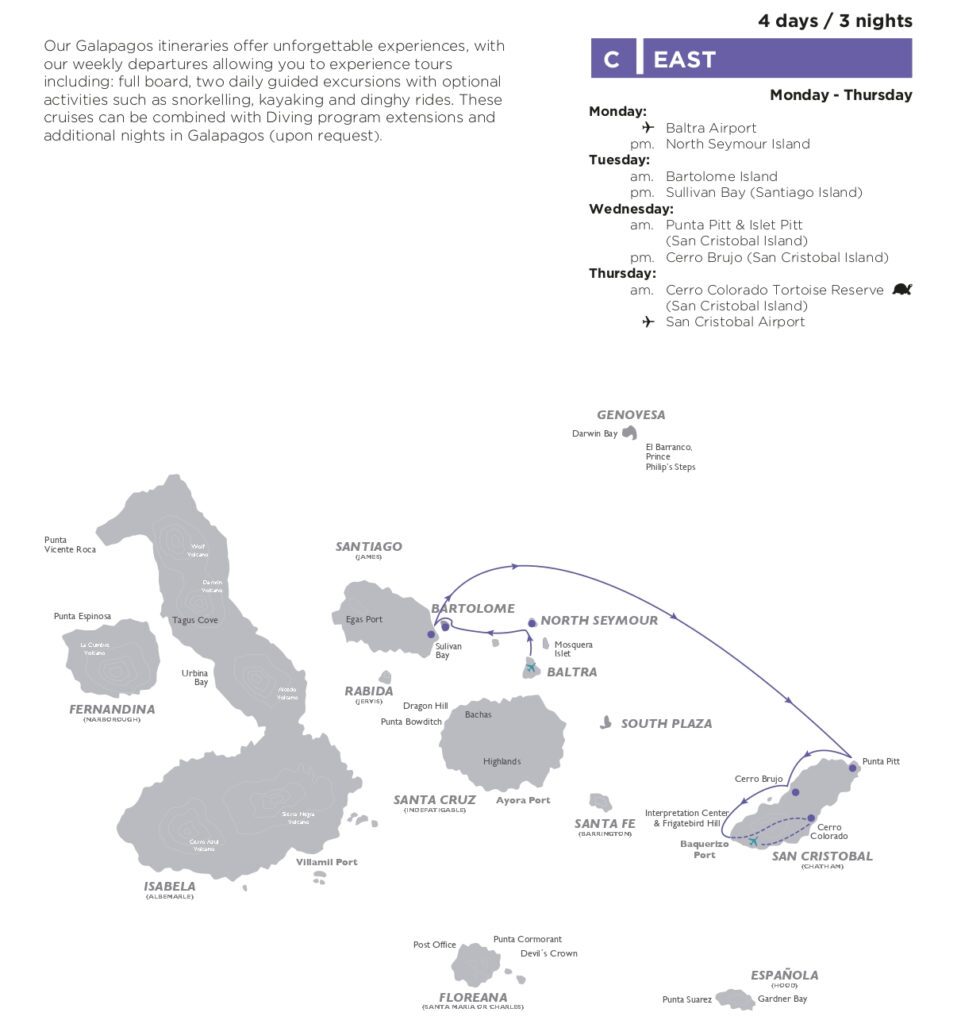
Day 1: Fly to Baltra, transfer to yacht. PM – North Seymour Island (L,D)
Departure from Quito or Guayaquil to Baltra Island (2.5-hour flight approx.).
Arriving in the Galapagos, you are picked up at the airport by your guides and taken to a ten-minute bus drive to the pier to board the Legend.
PM – North Seymour Island
Dry landing again, North Seymour is located just off Baltra Island and not far from Santa Cruz.
This landmass was formed by a series of underwater volcanic eruptions, which deposited layers of lava on the ocean floor. An approximately two-hour walk will take us amidst large nesting colonies of blue-footed boobies, magnificent and great frigate birds, and swallow-tailed gulls. You may also encounter land iguanas, and on a lucky day, you might even come across the endemic Galapagos Snake.
Difficulty level: intermediate
Type of terrain: rocky
Duration: 2-hour walk, 30-minute snorkelling
Day 2: AM – Bartolome Island. PM – Sullivan Bay (B,L,D)
AM – Bartolome Island
Bartolome offers a fascinating landscape formed by different volcanic parasitic cones —lava bombs, spatter, cinder cones and more.
Our aim is to climb stairs to the summit at Bartolome. From here there will be an impressive views of the surrounding islands, including the eroded tuff cone Pinnacle Rock. We also encounter marine iguanas, lava lizards, and blue-footed boobies en route.
There is some beach time here, too, and this is a great opportunity to do some snorkelling and see the famous Galapagos Penguins, sea turtles and White-tipped Reef Sharks among a great variety of colourful fish. For many visitors, this may turn out to be the best snorkelling experience in Galapagios. Crystal clear water is the perfect spot to appreciate the incredible marine life Bartolome has to offer.
Due to its geographical location, the lack of vegetation is immediately noticeable however, there are pioneer plants including the endemic Tiquilia nesiotica and Chamaesyce (known as sand mat or spurge in English), lava cactus, and Scalesia bushes.
Difficulty level: intermediate
Type of terrain: trail made of 372 steps.
Duration: 1 ½-hour walk / 1-hour snorkelling
Sullivan Bay is located at the southeastern portion of Santiago Island and is of important geologic interest. It features extensive Pahoehoe lava flows, believed to have been formed during the last quarter of the 19th century.
In the inland section of the trail and in the middle of the lava flow, older reddish-yellow-colored tuff cones appear. Here, Mollugo plants and their yellow-to-orange whorled leaves grow out of the fissures.
Walking on the lava is breathtaking, this flow is geologically very young, the magma formed is flat but the movement of underground lava, the rapid cooling, and other eruptions make it look like it has only just solidified. There’s also a chance for a cooling swim / snorkel in the sea.
Difficulty level: difficult
Type of terrain: flat volcanic lava
Duration: 1 ½-hour walk / 1-hour snorkelling / beach time
Return to the boat for dinner and briefing.
Day 3: San Cristobal, AM – Pitt Point. PM – Cerro Brujo (B,L,D)
Pitt Point & Islet
This is a wet landing followed by a great hike on rocky terrain. The trail takes in a 90m beach and a path that climbs to the top of a volcanic tuff, through several magnificent viewpoints.
This is probably the only site where the three booby species of the Galapagos can be seen together, as well as two species of frigate birds and a sea lion colony.
It is also excellent for dinghy rides and snorkelling, where a good range of sea birds can be observed.
Difficulty level: difficult
Type of terrain: rocky
Duration: 2½-hour walk/ 40-minute snorkelling – kayaking
PM – Cerro Brujo (San Cristobal)
Wet landing at Cerro Brujo, an eroding tuff cone composed of lava formations and a beautiful white sandy beach, great for snorkelling and sunbathing.
There is a lagoon visit where migratory bird species can be seen: Black-necked Stilts, Ruddy Turnstones, Whimbrels, other sandpiper species and White-cheeked Pintails.
Cerro Brujo offers beautiful views of Kicker Rock, the southern part of San Cristobal and the adjacent coast.
Difficulty level: easy
Type of terrain: sandy
Duration: 1-hour walk / 1-hour snorkelling
Day 4: Cerro Colorado Tortoise Reserve, transfer to San Cristobal airport, OR continue to itinerary D (B)
It’s a dry landing at the main jetty in Puerto Baquerizo Moreno, capital of San Cristobal and indeed all Galapagos.
We head to the Giant Tortoise Breeding Centre to learn about the National Park’s conservation programs, enjoying a beautiful landscape on the way to the Reserve. You also have the opportunity to visit the village’s port, have a drink or shop for arts and crafts and other souvenirs.
Difficulty level: intermediate
Type of Terrain: sandy
Duration: 40-minute bus drive to the Reserve / 1-hour visit
Baltra Airport
After the visit you head to San Cristobal Airport for your return flight to Guayaquil or Quito, OR continue with your visit and itinerary D.
Itinerary D: South
Itinerary D (5 days) Thu-Mon
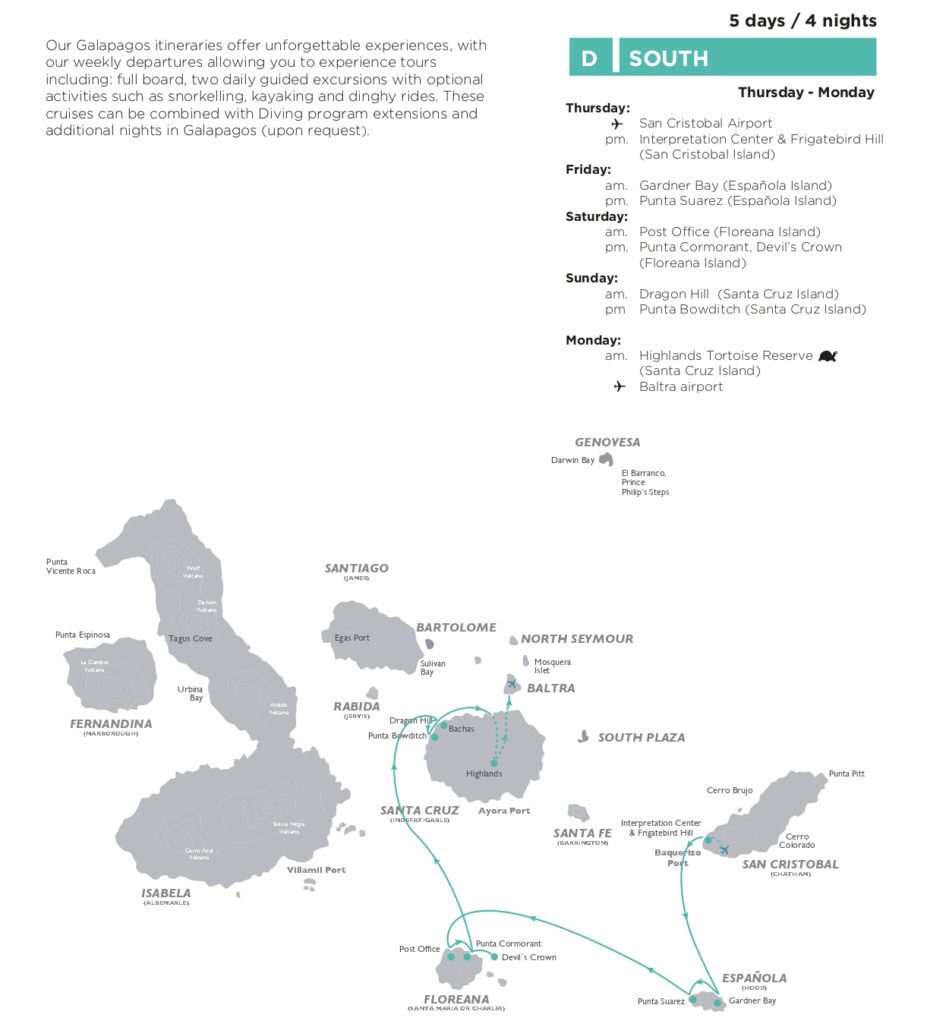
Day 1: Fly to San Cristobal, transfer to yacht. Interpretation Centre & Tijeretas Hill (L,D)
Departure from Quito or Guayaquil to San Cristobal in a 2-hour flight (approx.).
Upon arrival, you are picked up at the airport by Legend’s naturalist guides and taken on a ten-minute bus drive to the pier to board the Legend.
PM – Interpretation Centre & Tijeretas Hill (San Cristobal Island)
Dry landing in Puerto Baquerizo Moreno, the capital of the Galapagos Islands.
You visit the Interpretation Centre, an excellent place to learn about islands’ history in The Museum of Natural History. This displays information about the volcanic origins of the islands, their remoteness from the continent, ocean currents, climate, the arrival of the different species and their colonization, among other points of interest.
The human history is also showcased, chronologically narrating the most significant events related to the discovery and colonisation of the islands.
Difficulty level: easy /intermediate
Type of terrain: flat/stairs
Duration: 1-hour visit / 1-hour walk
Tijeretas Hill involves a high-intensity walk amidst beautiful landscapes and a magnificent view at the foot of a frigate bird nesting colony.
Difficulty level: difficult
Type of Terrain: rocky
Duration: 1-hour visit
Day 2: Española: AM – Gardner Bay, Gardner & Osborn islets. PM: Suarez Point (B,L,D)
Gardner Bay, Gardner & Osborn islets (Española Island)
Wet landing on a beautiful white coral sandy beach, often guarded by a colony of sea lions.
There are no trails, so we stay along the shore where we can spot Galapagos hawks, American Oystercatchers, Galapagos Ground Doves, Hood mockingbirds, Yellow Warblers, lava lizards and marine iguanas.
There are alo three species of Darwin’s finches: a subspecies of the Large Cactus Finch, which is similar to the large ground finch, the Small Ground Finch (Geospiza fuliginosa) and the Warbler Finch (Certhidea Olivacea), another endemic subspecies.
Swimming and snorkelling here offer a great showcase of the variety of the Galapagos’ marine wildlife: king angelfish, Creole fish, damsel fish, parrotfish, manta rays, and white-tipped reef sharks.
Difficulty level: easy
Type of terrain: sandy
Duration: 1-hour walk / 1-hour snorkelling
PM – Suarez Point (Española Island)
Dry landing. An island of geological interest, we explore volcanic formations and a riveting wildlife: large sea lion colonies and seabirds including the Española mockingbird, Nazca Boobies, and the spectacular Red-billed Tropicbird.
You may also encounter marine iguanas, lava lizards, and the colourful Sally Lightfoot Crabs.
A somewhat lengthy hike will bring you among Nazca and Blue-footed Boobies, right up to nesting grounds that sometimes overlap the trail. Other birding favourites include Galapagos Dove, Galapagos Hawk, Swallow-tailed Gulls and the world’s largest colony of Waved Albatross, an unequivocal highlight during mating season (May-December).
Admire the island’s dramatic backdrop, featuring the famous “Soplador”, a seaward blowhole that shoots up water up to 23m/75ft in the air.
Difficulty level: difficult
Type of terrain: rocky
Duration: 2½-hour walk
Day 3: Floreana: AM – Post Office Bay. PM – Cormorant Point, Devil’s Crown, Champion (B,L,D)
Wet landing to start today. Located on the north side of Floreana, Post Office Bay was so named because in 1793 Captain James Colnett installed a wooden barrel which served as an informal post office for sailors passing through. Anyone arriving here would take the letters with them, back to their destinations.
Today, visitors continue the tradition by placing unstamped postcards inside the barrel, hoping that some other traveller, going to the letter’s destination, will take it back for free.
We may also encounter Darwin’s finches, Yellow Warbler and Lava Lizards. Great snorkelling opportunities with turtles and sea lions from here, too.
The island is alsoknown for its endemic vegetation: Scalesia villosa, Lecocarpus Pinnatifidus, and the Galapagos Milkwort.
Difficulty level: easy
Type of terrain: sandy
Duration: 30-minute walk / 1-hour snorkelling
PM – Cormorant Point / Devil’s Crown / Champion (Floreana)
Wet landing, on an olivine green, sanded beach.
We hike from the black mangrove beds to a brackish lagoon, which usually holds one of the largest flamingo populations in the Galapagos.
This island features some endemic plants such as Scalesia villosa, white and black mangrove, and holy stick. The trail continues to a beautiful white sandy beach, one of the most important nesting sites of Green Pacific Sea Turtles. It is important to avoid walking in the water due to the sting rays that may be hiding in the sand, which can be dangerous if accidentally stepped on.
From the beach, one can spot sea turtles, blue-footed boobies plunging into the water, and small reef sharks floating along the shoreline in the search for food.
This coral-sand beach marks the end of our trail, and we head back to the olivine beach we landed on, to swim or snorkel amongst sea turtles, reef fish, sea lions and, on a good day, white-tipped reef sharks. A small colony of penguins resides on Floreana and can sometimes be observed as well.
Difficulty level: easy walk, intermediate snorkel
Type of terrain: sandy & flat
Duration: 1-hour walk / 1-hour snorkelling
Day 4: Santa Cruz: AM – Dragon Hill. PM – Punta Bowditch (B,L,D)
AM – Dragon Hill
A small lava dock gives us a chance to spot marine iguanas — look carefully, they blend in with the dark, volcanic background. Our destination is Dragon Hill, a sickle-shaped beach where flamingos come to feed. The path there takes us past large prickly pear cacti, often giving us views of the flamingos. Waders like stilts, turnstones, and sandpipers also look for food at the water’s edge. We’ll head inland to a dry forest to see land iguana’s nests and burrows before returning to the boat.
Difficulty level: Intermediate
Type of terrain: Rocky
Duration: 2-hour walk
PM — Punta Bowditch
This powdery beach has seen very few souls. We take 30 minutes to arrive there on foot, and then enjoy a snorkel in Punta Bowditch’s turquoise waters and islets. This is a beach that transports you to the Galapagos Islands as they were before discovery.
Difficulty level: Easy
Type of terrain: Sandy
Duration: 30 minutes walk, 1-hour snorkelling
Day 5: Highlands Tortoise Reserve, transfer to Baltra airport, OR continue to itinerary A (B)
Highlands (Tortoise Reserve)
In the highlandsof Galapagos it is possible to find many different kind of birds: tree and ground finches, vermillion flycatchers, paint-billed crakes, yellow warblers, and cattle egrets (usually standing on the tortoises’ shell).
The journey to the highlands offers a great chance to see the contrasts that the island offers, with its variety of ecosystems. The road goes from the coast through the agricultural zone and straight up to the dense humid forests. Often, Galapagos Giant Tortoises are seen on the way, wandering through pastures in the paddocks. This spot is a birdwatchers’ haven, since almost every land bird present on the island lives or migrates here.
Difficulty level: easy
Type of terrain: flat & muddy (depending on season)
Duration: 45-minute drive / 1 ½-hour walk
Baltra Airport
After the visit, we transfer you to the airport for your return flight to Guayaquil or Quito, OR continue on to itinerary A.
Prices From $4,292 / £3,489 per person
What's Included?
Accommodation in sea view cabins with air-conditioning & private, ensuite bathroom, meals as listed, welcome & farewell cocktails, BBQ, coffee / tea station, multilingual speaking naturalist guides English-Spanish (French, German, Italian, upon request), snorkeling opportunities, optional diving (please ask, extra cost), outside deck use
What's Not Included?
International flights, Round trip flights to the Galapagos Islands, Galapagos National Park fee, Galapagos Ingala fee, soft and alcoholic and bottled drinks, personal items, souvenirs, tips, wetsuit hire, kayak use, internet, travel insurance, personal items, Ecuador services
Accommodation
The M/V Galapagos Legend has 52 ocean view, air-conditioned cabins plus 3 interior ones, each cabin counts with lower beds and private facilities in which a matrimonial, double, triple or quadruple options are available.
The Balcony suites have private balconies and panoramic windows to immerse yourself within the vast landscape that you are about to witness and enjoy it privately. The Junior suites have three meters of panoramic windows to enjoy the scenery.
Sea view cabins with the following general features:
• Lower twin beds or double beds
• Private bathroom
• Safe-deposit box
• Air conditioning
• Phone service for internal, local and international calls
• LCD TV with multimedia system
Legend Balcony Suite
Biggest and most comfortable cabin with plenty of space to move around freely.
- 1 cabin located on the Moon Deck.
- Double & Triple options.
- Panoramic windows & private balcony.
- Exclusive & exquisite decoration.
- Complimentary champagne bottle.
- Average Area 33 m2 / 355 ft2.

Balcony Suite Plus & Balcony Suite
One of the most striking aspects of theship: 17 top of the line Balcony Suites are located in the Sky Deck and the Moon Deck, measuring an average of 22m2 (237 ft2).
- 9 Balcony Suites on the Moon Deck.
- 8 Balcony Suites on the Sky Deck.
- Double & Triple options.
- Panoramic windows & private balcony.
- Complimentary champagne bottle.
- Average Area 22 m2 / 237 ft2.

Junior Suite Plus & Junior Suite
Featuring big panoramic windows to admire the landscape, offering a wide variety of arrangements in Double & Triple and interconnected configurations, enjoy the perks of having the family together in private quarters with even more space for your comfort.
- 24 Junior & 4 Junior Plus Suites on the Earth Deck.
- Double, Triple & Quadruple options.
- 2 Panoramic windows per cabin.
- Interconnected options available.
- Average Area 15 m2 / 161 ft2 in Junior Suites.
- Average Area 20m2 / 215 ft2 in Junior Suites Plus

Standard & Standard Plus Cabins
10 comfortable cabins, located on the Earth and Sea Decks.
Standard Plus
- 7 cabins on the Sea & Earth Deck.
- Double options available.
- 2 portholes per cabin.
- Average Area: 11 m2 / 118 ft2
Standard
- 3 cabins on the Earth Deck.
- Single & Double options.
- Interior accommodations.
- Average Area: 13 m2 / 140 ft2.

Tour Staff
The crews are “Galapagueños”, guides, captains and crew members were born and raised in the Galapagos Islands.
They know the area well and are prepared to show you the islands only like a native can do it.
The Naturalist, English-speaking guides have studied and been trained at Charles Darwin Scientific Station, and have long years of experience guiding at the Galapagos Islands.
Meals
The boat uses as much locally sourced produce as possible, including fish, coffee, eggs, fruits and meat farmed in Galapagos, to reduce carbon footprints and make sure the best ingredients are used.
The chef prepares three main meals a day, with snacks and drinks available after activities.
All dietary requirements can be catered for, vegetarians, vegans, lactose intolerant and more.
Breakfast usually features a juice, tea and coffee, toast, jams, eggs and pastries.
Lunch will include soups, then a main meal of rices, pastas, fish, omelettes and many more options, and often a small pudding.
Dinner will again be a hearty affair, with a starter, main meal and pudding, with water, teas and coffees available.
There is a bar with beers and cocktails available at extra cost.
Activity Level
Walks
Every visit to each island involves an easy or moderate walk, which can last between 2 to 3 hours, and are not considered strenuous. On these walks you will be led by an expert naturalist guides in a small group along clearly marked trails. They will explain in great detail all the wonders of each of our carefully selected itineraries. Most days there are two guided walks on a specific island where you will be able to walk and hike on beaches, lava fields, alongside cliffs and around mangrove estuaries.
Snorkelling
Snorkelling in the Islands is the highlight of the Galapagos cruise for many of our guests. You have the opportunity to go snorkelling almost every day – snorkelling with marine iguanas and with playful sea-lions are some of the highlights, as well as with green sea turtles, penguins and an incredible variety of colourful reef fish. On the western islands the water is a little colder but teaming with life. There are beach snorkels for beginners and deeper waters.
Zodiac rides
Dinghies, or “Pangas” as they are known in Galapagos, are inflatable zodiacs that serve as the main transportation method from our Galapagos yachts to the visitor sites. At several times during your week-long Galapagos travel adventure, you will have the chance to enjoy dinghy (or panga) rides in shores, mangrove estuaries, coves and caves.
Scuba diving
Dive with professional dive masters and instructors. You can do a couple dive tours in a day. Ideal for divers who would like to share with their family and friends a Galapagos cruise, but still want to see the amazing underwater world of the Galapagos.
- Min 2 people, max 8 people.
- 2 immersions in 4-hour trip, each dive 45-60 mins
- Included dive equipment (tank, weights, wetsuit, fins, mask, regulator, bcd, snorkel).
Kayaking
New, transparent kayaks – watch the fish while kayaking. All kayaking activities are in the company of a naturalist guide, and the boat supplies all necessary kayak and safety equipment.
Glass bottom boat
Stay dry yet still share in the magic of the Galapagos submarine environment. Accompanied by a naturalist guide, head to the best vantage points to look down into the underwater world.
Practical Information
Is this the cruise for me?
The Legend is perfect for those wanting a stable boat, great itineraries and a mix of activities and cabins to suit all tastes.
Divers, relaxers, hikers and kayakers in one group? No problem – the Legend has something for all of you.
During school holidays, it’s particularly apt for families with its interconnecting rooms and specially designed activities.
Introduction to Galapagos
These magical islands comprise of 50 volcanic islands of varying shapes and sizes, which lie 1,000 kilometres off the coast of Ecuador.
Here, unlike anywhere else on Earth, you can enjoy a thousand close encounters with a weird and wonderful variety of ‘friendly locals’, including giant tortoises, fur seals, sea iguanas, frigate birds and blue-footed boobies.
Read our Galapagos Islands Guide and more about diving.
In 1535, Tomás de Berlanga, Bishop of Panama, floated into this archipelago and named it Galapagos after the giant tortoises he encountered. Pirates used the islands for refuge and to bury their stolen treasure after that.
The islands’ most celebrated visitor was Charles Darwin, who arrived aboard the HMS Beagle in 1835. The rare life forms he encountered helped him formulate his theory of evolution, which he published in The Origin of Species by Means of Natural Selection.
It wasn’t until 1959 when it became part of Ecuador’s national park system that this fragile ecosystem with its rare and endemic species came under protection.
In 1979 the Galapagos archipelago was declared a UNESCO World Heritage Site.
Weather in Galapagos
When to visit Galapagos Islands: weather and wildlife
There is no real ‘best’ time to visit Galapagos on holiday as there is always wonderful wildlife and weather to enjoy. Read our blog for more.
Most animals – tortoises, sharks, sea lions and boobies – are found year round and many of the species here are non-migratory.
The Galapagos Islands are located right on the equator so air and water temperatures do not vary by much.
Having said that, there are two recognised seasons, and each months brings natural marvels for the visitor to enjoy.
Below is our quick guide to the weather and wildlife you can find on the Galapagos Islands.
General weather information
The warm season (Jan-Jun)
- Calm, clear warm waters, great for snorkelling, often without a wetsuit.
- Great weather, with February and March being the hottest and sunniest months with blue skies and sunshine.
- Occasional heavy bursts of rain in the afternoons.
Sea temperatures: 22-25°C / 72-77°F
Land temperatures: 21-32°C / 72-90°F
The dry ‘garua’ season (Jun-Dec)
- It’s a great time for marine life in the cooler seas. Snorkellers may want a wetsuit.
- August and September the coolest when you may need a jacket in the evenings and the sea can be choppy.
- There can be mist on the islands in the mornings (garua) which usually burns off by midday leaving overcast skies or a sunny afternoon.
Sea temperatures: 15-22°C / 60-72°F
Land temperatures: 18-24°C / 65-75°F

Air and sea temperatures in Galapagos, month-by-month
Galapagos cruise typical day
Read about a day aboard a Galapagos cruise ship in Tom’s blog.
After breakfast aboard your vessels, you go ashore or for a snorkel with your naturalist guide in a small boat, called a “panga”.
Well marked paths lead you to fascinating wildlife discoveries, including sea lions, iguanas and Galapagos penguins.
Snorkeling is encouraged, with opportunities most days to explore an incredible underwater world and enjoy close encounters with a host of colourful fish, sea lions and sea turtles.
You return to your vessel for lunch, followed perhaps by a short siesta while sailing to the next visitor’s site. The rest of the afternoon is spent on shore or snorkelling, before returning to your boat to enjoy a spectacular sunset.
After dinner, your naturalist guide will usually offer a briefing on the next day’s activities.
Since each island has its own unique landscape and diverse animal, bird and plant species, every day is a new adventure.
If you are worried about seasickness, read our blog about Galapagos and avoiding seasickness.
Itineraries
Read our guide to Galapagos itineraries.
Galapagos boats may change itineraries without notice if necessary.
This could be due to Galapagos National Park regulations, weather conditions, route availability or to allow the cruise to reach its desired visiting point.
Boat may also change itinerary to prevent the migration and protect the flora and fauna of the Galapagos Islands, domestic flight alterations and acts of providence.
Passengers embarking
Please note that there may be changes of passengers on some days throughout the cruise, which may result in waiting times for remaining passengers.
Equally, if passengers are arriving and leaving on different flights there may be waiting times either on board or at the airport.
Food
Please remember the isolated location of the Galapagos – any food on board is flown in from the mainland.
This may mean limited meals choices on board, and while special dietary requirements (vegetarian/vegan/etc) are catered for, there will likely be a limited selection.
Fitness and experience
The Galapagos Islands are a suitable destination for most ages and fitness levels. Walks are generally short, although some volcano hikes are more challenging and may involve 2-3 hours of walking. Snorkelling is a real highlight on the Galapagos, so the ability to swim and snorkel is recommended. Snorkelling is suitable for those that have never tried before.
You need to be able to make some wet landings i.e. stepping out of a panga onto a sandy shore, and you may need to ascend or desend small ladders when getting on or off boats at docks or to snorkel.
The fitter you are, the more you will enjoy the Islands, but they really are accessible to all. You can choose to skip any activities you do not wish to partake in.
Read more in our blog about a typical day on Galapagos.
Tipping
Tipping is entirely voluntary and how much you give depends on how you feel about the service you have received.
This is a rough guideline – please note that all Galapagos tips must be left in USD cash.
- Galapagos guides: USD 5-10 per person, per day.
- Boat crew: USD 5-7 per person, per day.
And then throughout mainland Ecuador:
- Airport porters: Minimum USD 1-2 per bag – compulsory.
- Hotel staff: USD 1-2 per night, in the staff tip box.
- Transfer drivers/taxis: Generally not expected.
- Drivers: USD 10-25 per day total from the group.
- Restaurants: +10% for adequate to excellent food and service.
Prices From $4,292 / £3,489 per person
2025 price, standard interior cabin
USD 4,292 per person
Based on 8 days / 7 nights
Shorter/longer cruises available
Upgrades to sea view cabins and suites available
Single supplements apply
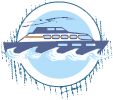
Dates & Prices
Prices From $4,292 / £3,489 per person
2025 price, standard interior cabin
USD 4,292 per person
Based on 8 days / 7 nights
Shorter/longer cruises available
Upgrades to sea view cabins and suites available
Single supplements apply
Can’t find what you’re looking for? Get in Touch
+44 (0)131 378 5593
+44 (0)131 554 6025



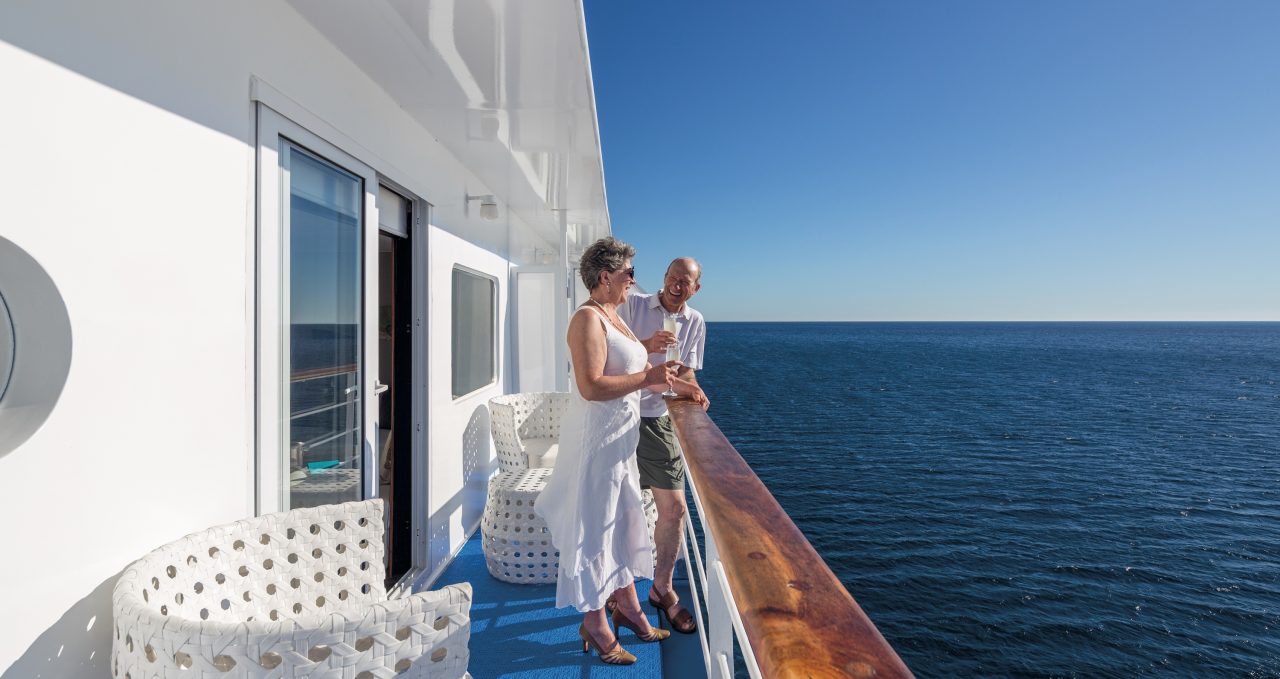
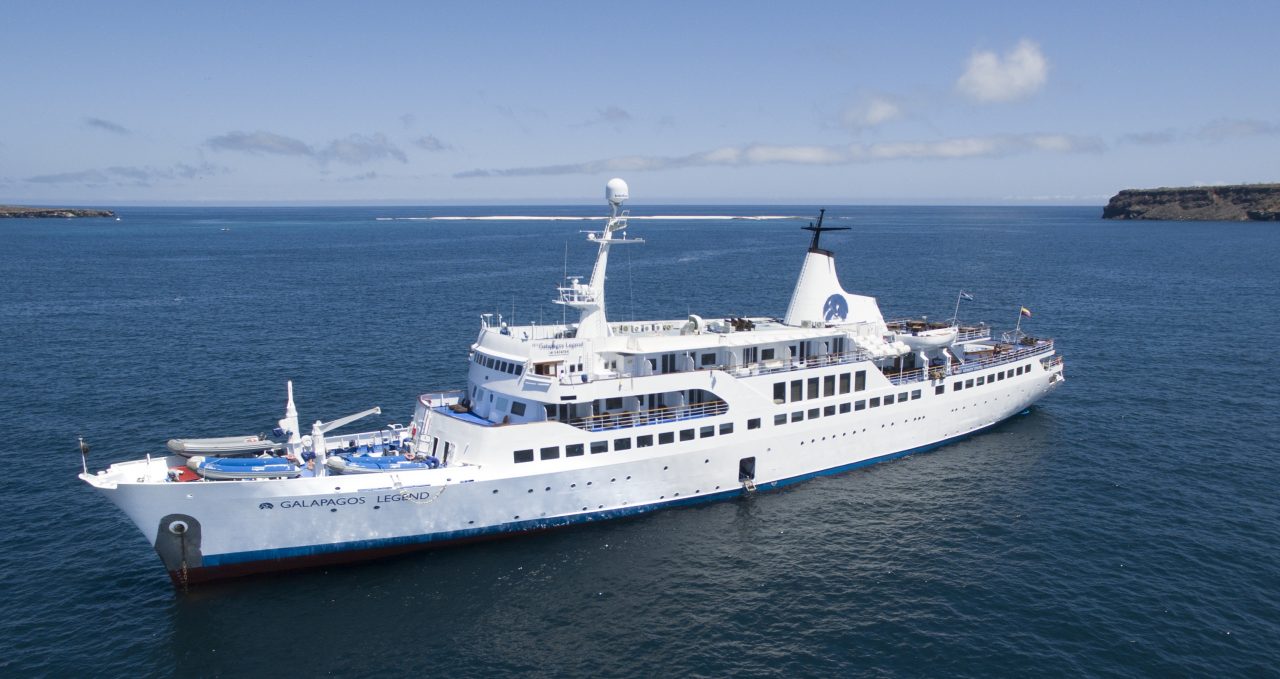
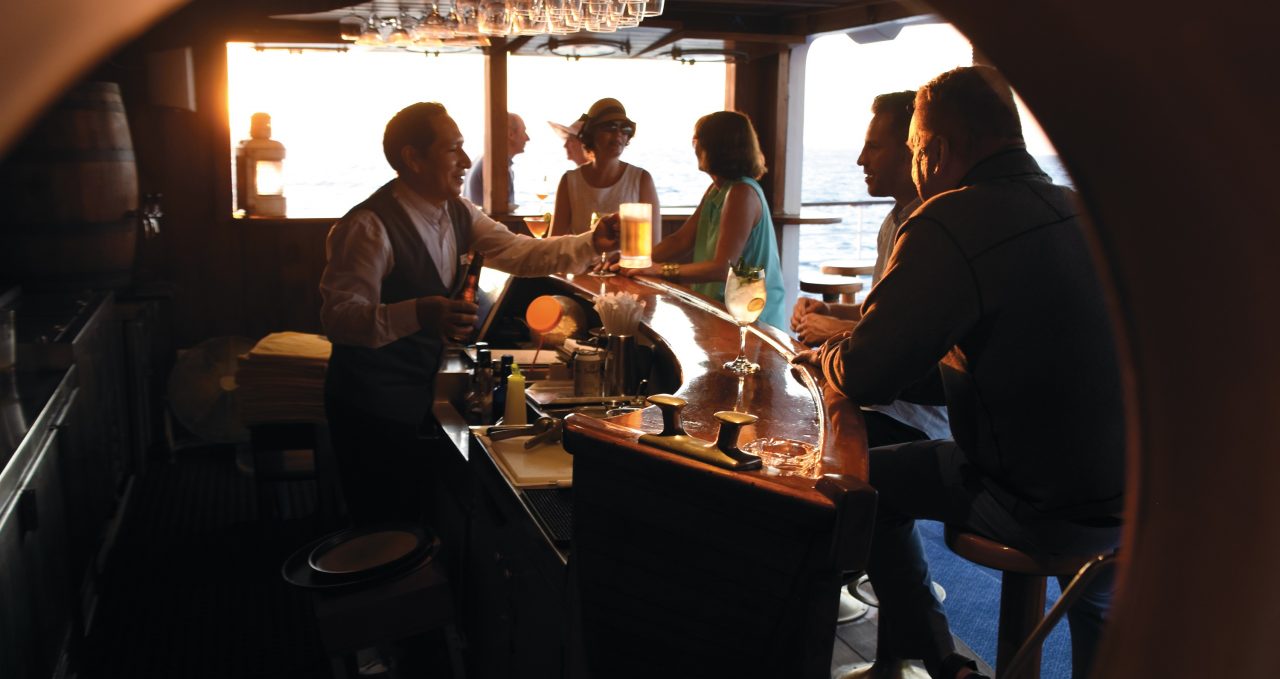
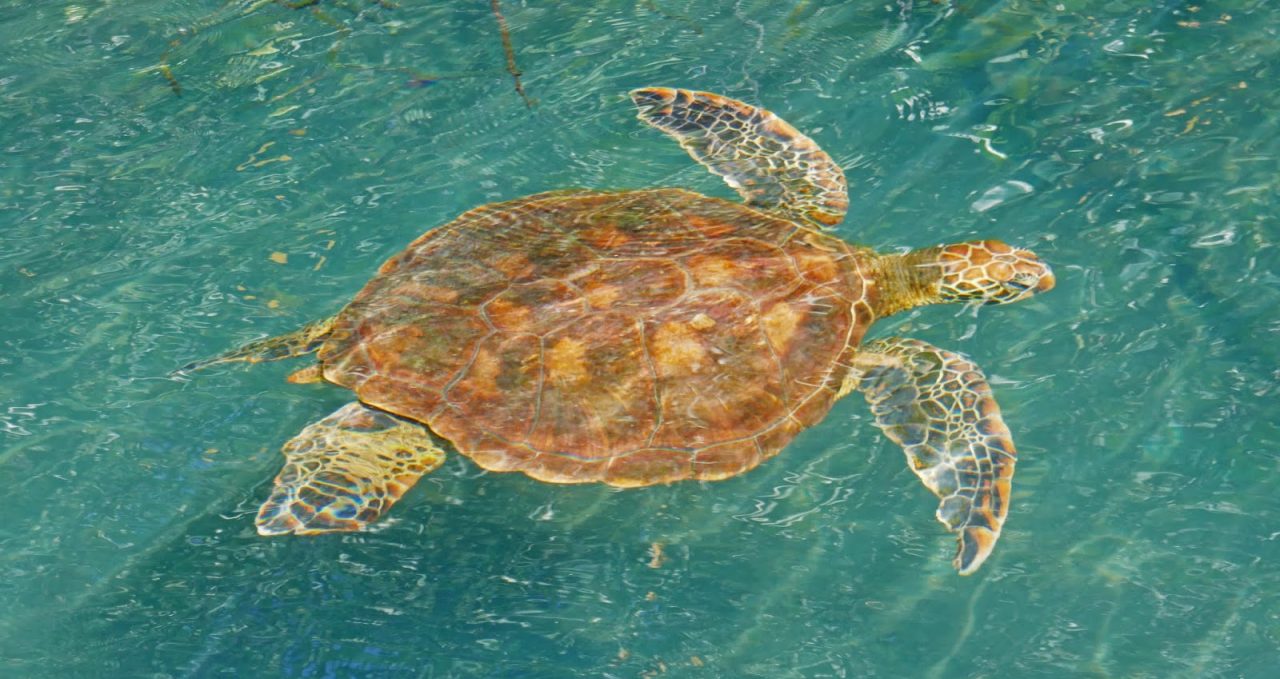
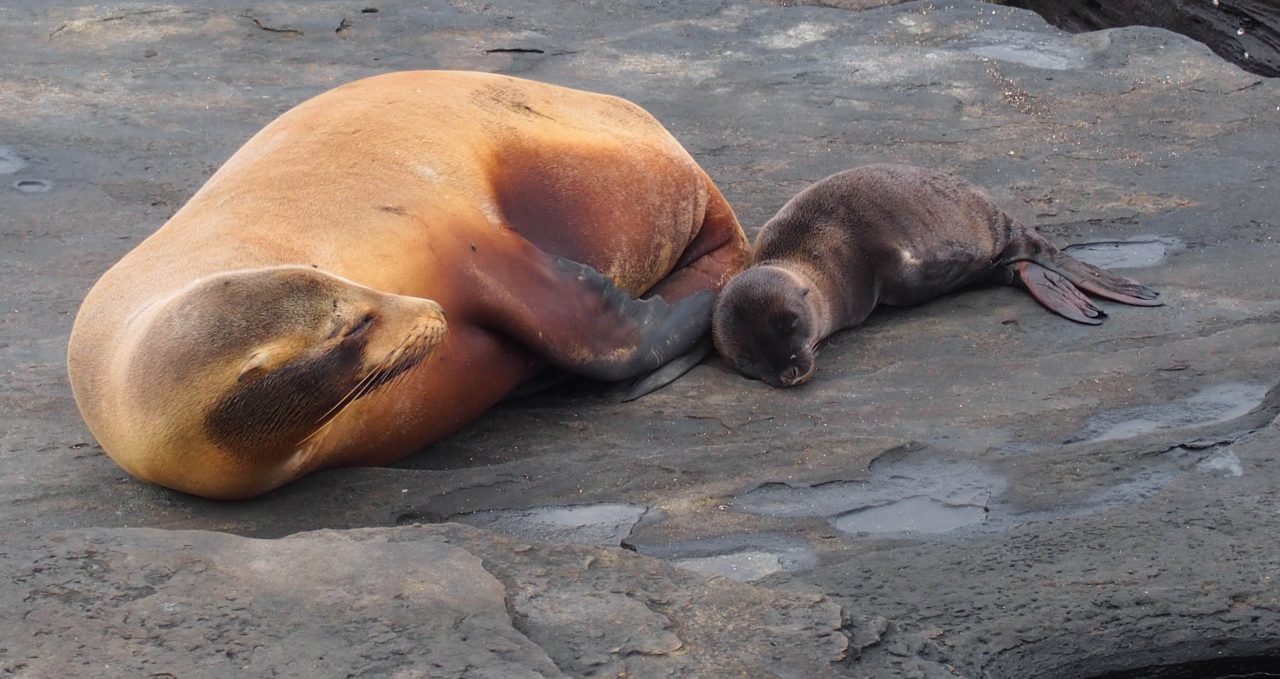
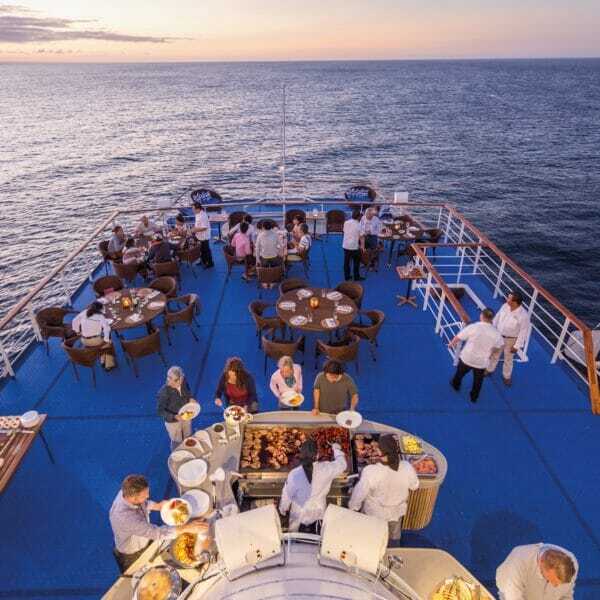
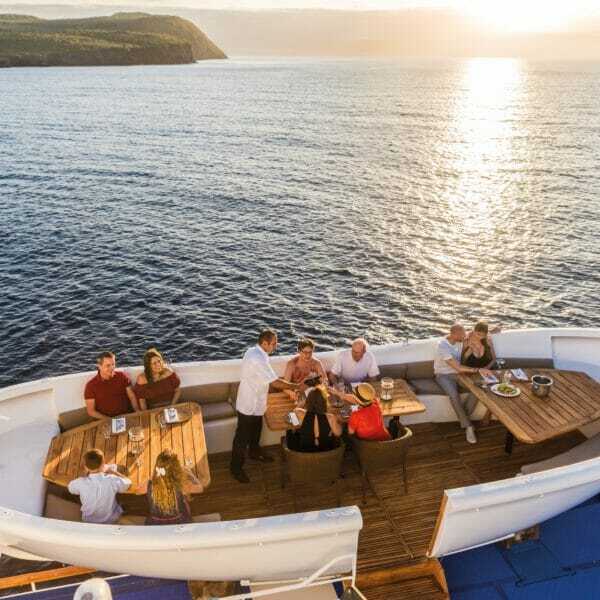
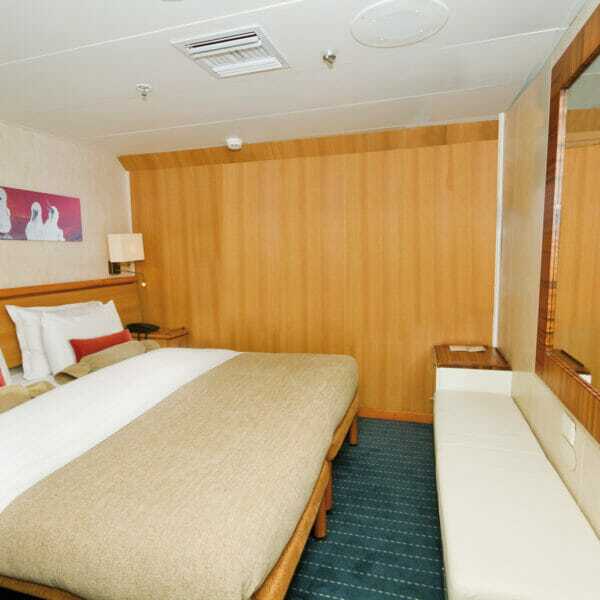
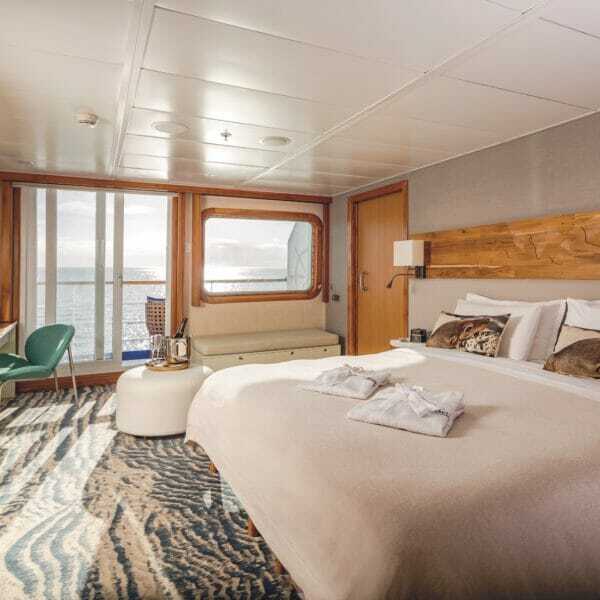
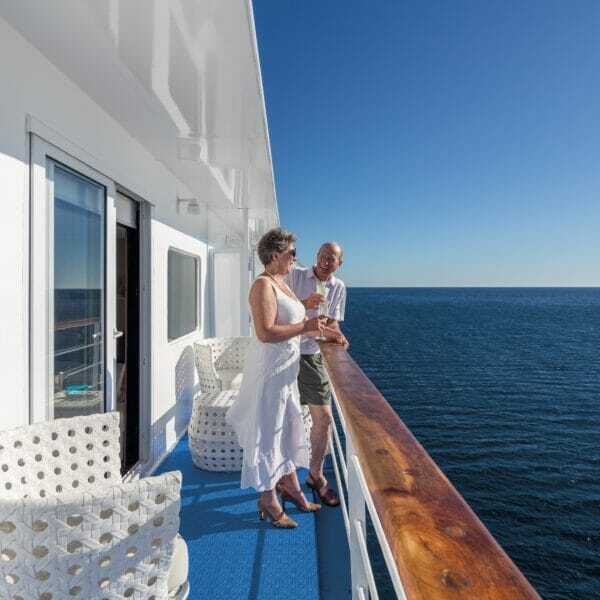
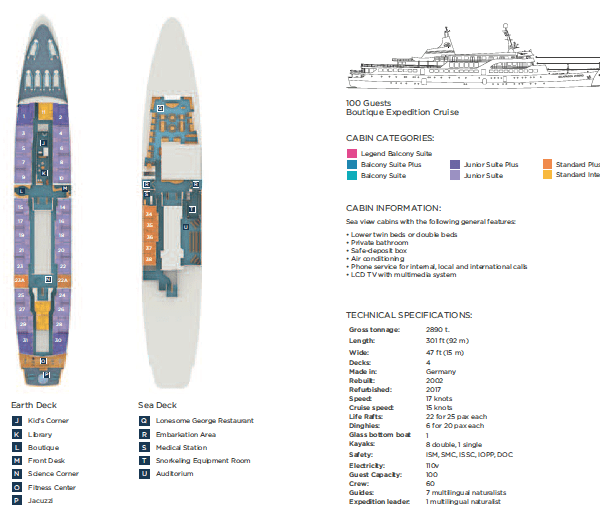
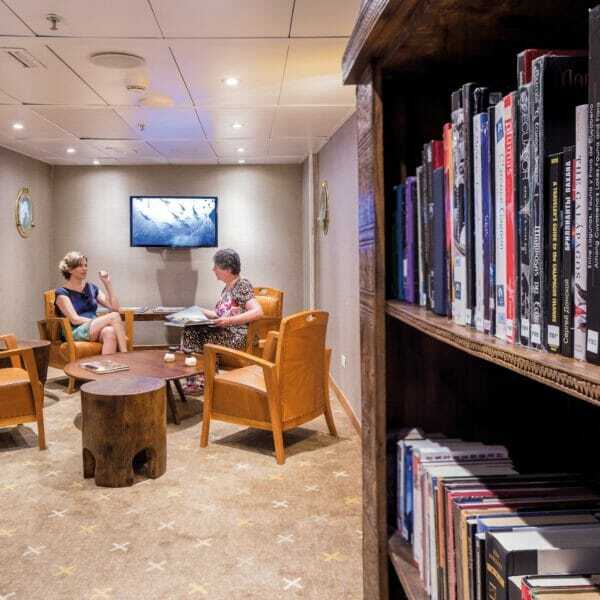
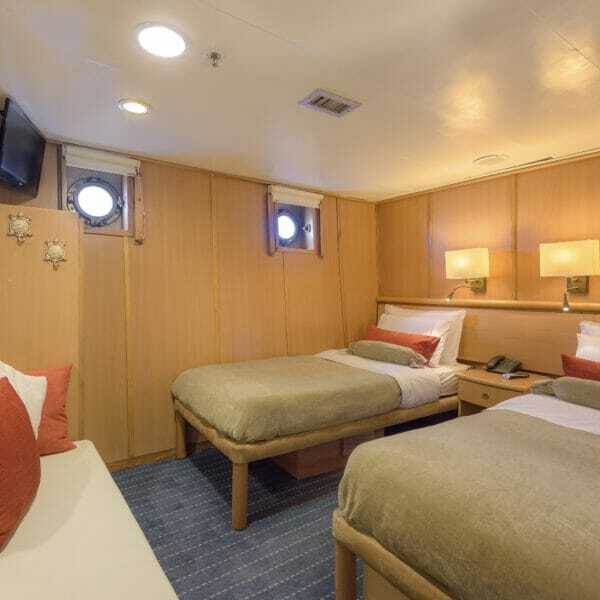

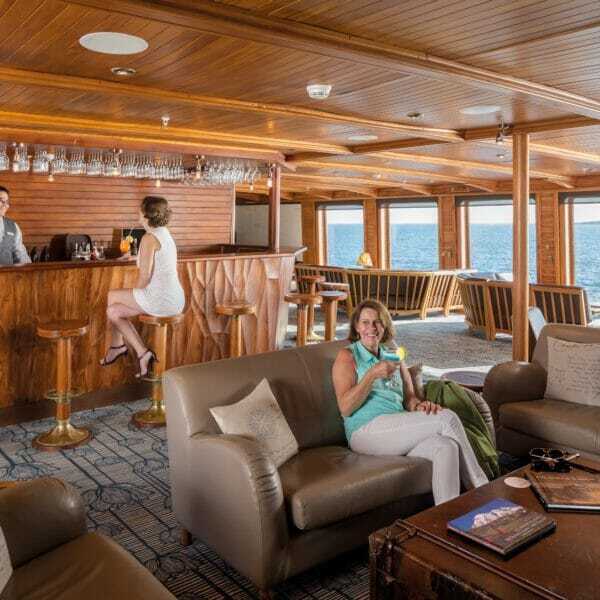
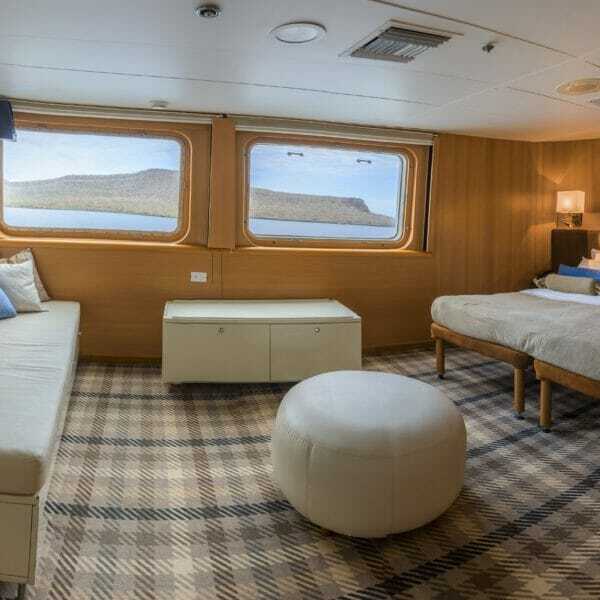
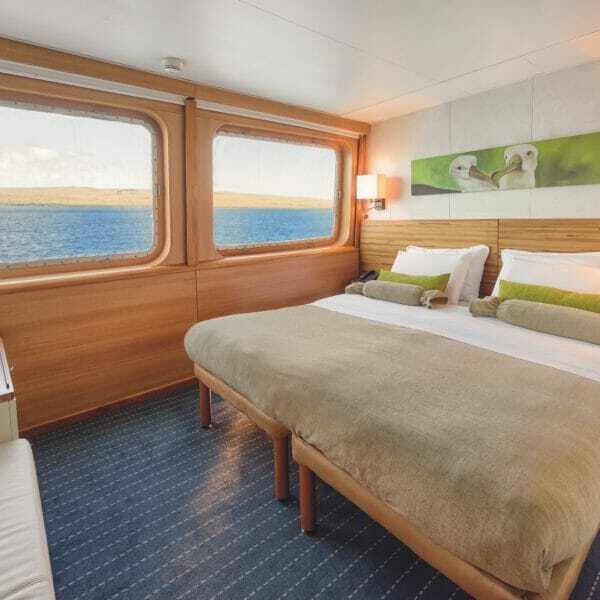
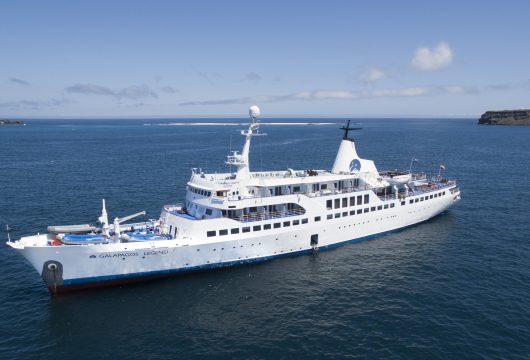
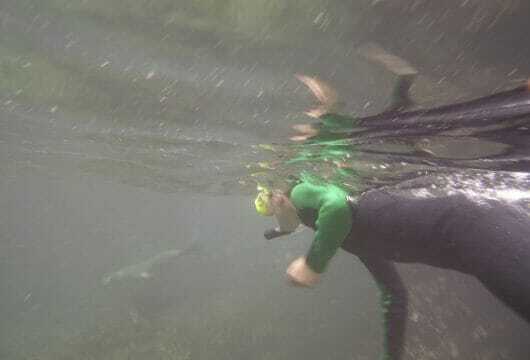

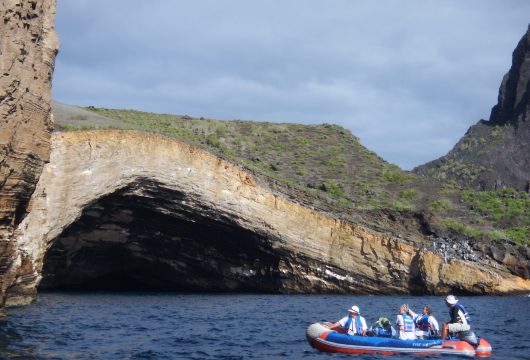
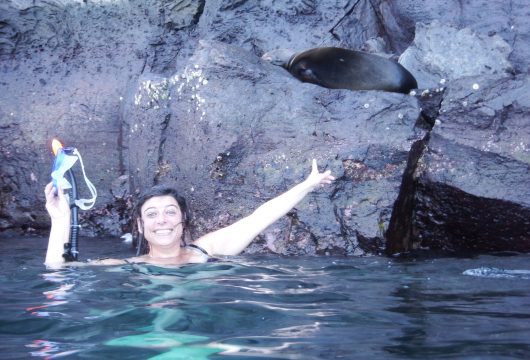
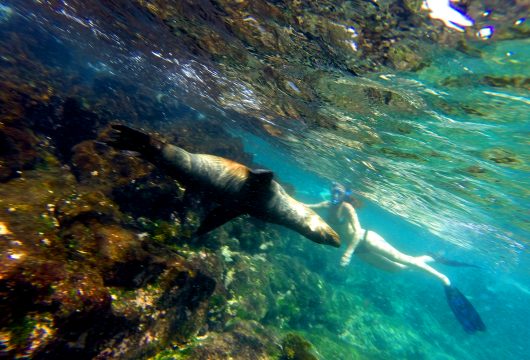
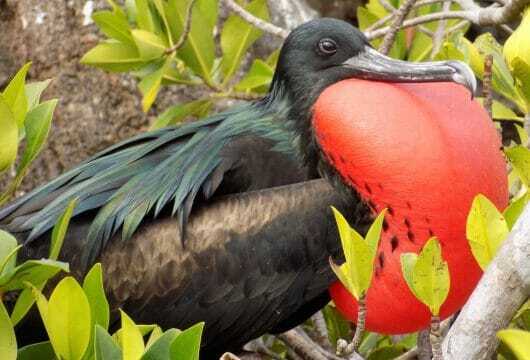
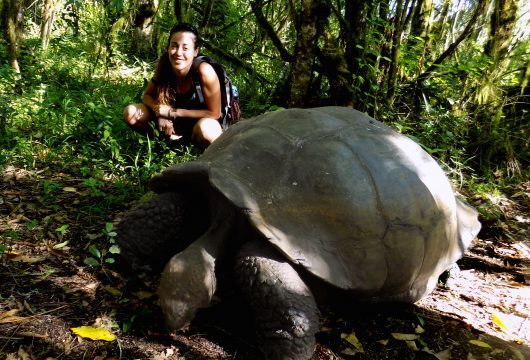
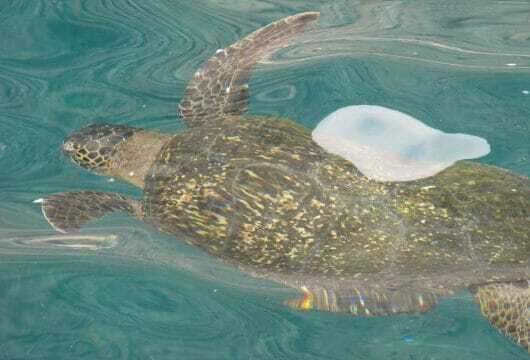
 a Group Tour
a Group Tour 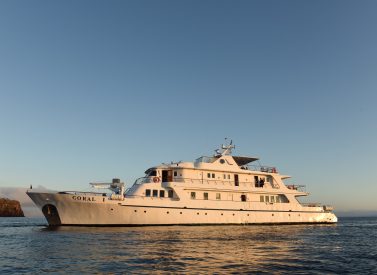
 a Tailor Made Tour
a Tailor Made Tour 